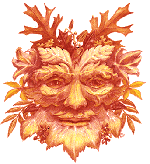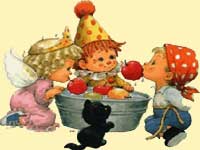2000 Years of Halloween HistoryThe history of Halloween goes back more than 2,000 years. The earliest
celebrations of Halloween were among the Celtic who lived in the areas which
are now Ireland, Great Britain and Northern France. The Celts were people who worshiped the beauty of nature. They worshiped the Sun God and believed that without him, they would not live. They also worshipped Samhain (pronounced sow-in) who was the lord of the dead and of the cold, dark winter season. They believed that on October 31 Samhain would call together all of the dead and these souls would take on the shape of an animal. They believed that all creatures wandered the Earth on that night. This was called the Vigil of Samhain. The Celts celebrated their new year on November 1. This day marked the end of summer and the harvest and the beginning of the dark, cold winter, a time of year that was often associated with human death. As already mentioned the Celts believed that on the night before the new year, the boundary between the worlds of the living and the dead became blurred. On the night of October 31, they celebrated the festival of Samhain, when it was believed that the ghosts of the dead returned to earth. The Druids, or Celtic priests, would build fires on the hilltops in belief that the large fires would help to strengthen the Sun God, and give him power enough to overcome the lord of darkness so that the sun season could continue. They believed that the fires were sacred, therefore they burned dried crops and sacrificed animals to help strengthen the Sun God. At midnight they stop worshipping the Sun God and start to worship Samhain because he will be the ruler for the next six months. This is the starting of the new year (1st November). They would perform ceremonies through the night to ask the spirits to tell the future of the upcoming year. For clans entirely dependent on the volatile natural world, these prophecies were an important source of comfort and direction during the long, dark winter. In the morning each household receives an ember from the fire, this ember is used to start fires in their own homes with the belief that it will ward off evil spirits in the new year. The Celts continued with their ceremonies until they were conquered by the Roman Catholics. By A.D. 43, Romans had conquered the
majority of Celtic territory. In the course of the four hundred years that
they ruled the Celtic lands, two festivals of Roman origin were combined with
the traditional Celtic celebration of Samhain. The first was Feralia, a day in
late October when the Romans traditionally commemorated By the 800s, the influence of Christianity had spread into Celtic lands. In the seventh century, Pope Boniface IV designated November 1 All Saints' Day, a time to honor saints and martyrs. It is widely believed today that the pope was attempting to replace the Celtic festival of the dead with a related, but church-sanctioned holiday. The celebration was also called All-hallows or All-hallowmas (from Middle English Alholowmesse meaning All Saints' Day) and the night before it, the night of Samhain, began to be called All-hallows Eve and, eventually, Halloween. Even later, in A.D. 1000, the church would make November 2 All Souls' Day, a day to honor the dead. It was celebrated similarly to Samhain, with big bonfires, parades, and dressing up in costumes as saints, angels, and devils. Together, the three celebrations, the eve of All Saints', All Saints', and All Souls', were called Hallowmas. Thus the Christian church tried to eliminate the Druid celebration by offering All Saint's Day as a substitute. As Christianity spread over Europe and the British Isles, it attempted to replace the pre-existing pagan cult worship of Apollo, Diana or Ymir, but to no avail. Although the outward forms of such worship disappeared, the belief in these deities did not. They found an outlet during the Middle Ages in the open practice of witchcraft which is presently enjoying a revival in many countries, including the U.S. In Germany the occult is considered more prevalent than in the Middle Ages. The deistic cults held periodic meetings known as witches sabbaths, and it is the same today with October 31st being of more importance. The Halloween traditions have transpired through the ages from one generation to another. We follow them mostly as did our dads and grandpas. And as this process goes on, much of their originality get distorted with newer additions and alterations. It happens so gradually, spanning over so many ages, that we hardly come to know about these distortions. But most of them whether it be "Trick or Treat", Halloween Costumes, Jack O Lantern and most of them can be traced back to the prevailing myths and practices of 2000 years back.
|

 the passing of the
dead. The second was a day to honor Pomona, the Roman goddess of fruit and
trees. The symbol of Pomona is the apple and the incorporation of this
celebration into Samhain probably explains the tradition of
"bobbing" for apples that is practiced today on Halloween.
the passing of the
dead. The second was a day to honor Pomona, the Roman goddess of fruit and
trees. The symbol of Pomona is the apple and the incorporation of this
celebration into Samhain probably explains the tradition of
"bobbing" for apples that is practiced today on Halloween.
